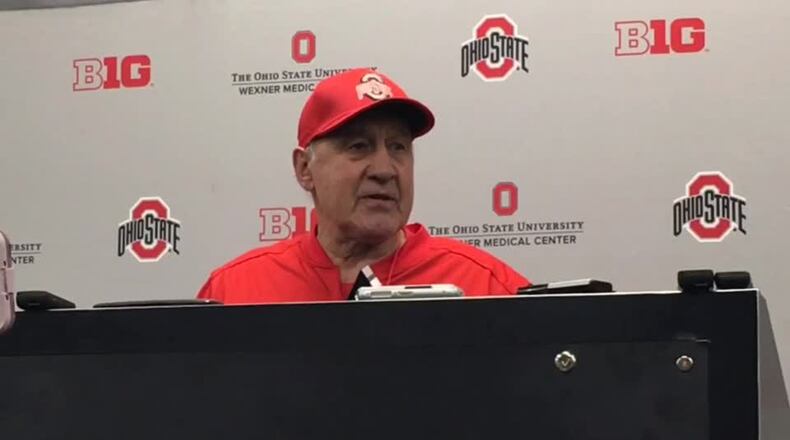1. Greater variety of coverages
After more than a decade pining for a return to the high-pressure defensive style that was a trademark of the original Silver Bullet defenses of the 1990s, Ohio State fans soured fast on defensive coordinator Greg Schiano’s schemes.
Schiano and head coach Urban Meyer took pride in being able to say they challenged every throw — until repeated breakdowns led to big plays that sunk the unit as a whole last season.
Ohio State football previews: Quarterbacks | Running backs |Offensive line | Receivers
Often those breakdowns were a result of opponents having an edge in game-planning because they knew what the Buckeyes would be doing.
New co-coordinators Greg Mattison and Jeff Hafley are expected to install multiple zone coverages to give quarterbacks different looks, but that does not mean man coverage is going back in mothballs.
“I think that we are still going to press people,” Hafley said. “I totally believe in pressing, especially in man-situations, especially with some of the guys that we have that are really long and very talented. I just think that you have to mix things up. I think you have to give corners the ability to zone off and be able to play off the quarterback to try and go make some plays.”
Hafley’s history working in the hybrid man/zone scheme made famous by the Seattle Seahawks “Legion of Boom” at the next level gives reason to believe Ohio State will use some man principles even within some zone coverages.
“I also think you also get tired playing man the whole game, which you have got to protect those guys sometimes and mix it up and make the quarterbacks think.”
2. A deeper defensive line
This was supposed to be the strength of the team last year, but it did not work out that way.
Ohio State lost Nick Bosa in the first month of the season while fellow starters Dre’Mont Jones and Robert Landers were banged up for much of the year. Bosa’s replacement, Chase Young, had a productive sophomore season overall despite playing on bad ankles that slowed him for more than a month.
A handful of youngsters were thrown into the fire last season and performed admirably, but they weren’t able to deliver the dominance expected from the likes of Bosa and Jones if healthy.
With a year under their belt, highly regarded prospects such as Tyreke Smith, Tyler Friday, Taron Vincent and Tommy Togiai (along with redshirt freshmen Jovantae Jean-Baptiste and Alex Williams) should be more productive when coach Larry Johnson calls their number.
3. Better fundamentals
This is the most boring of the answers, but it is probably the most important.
Schiano wasn’t trying to reinvent the wheel last season. Generally he was using schemes that had worked in the past at Ohio State. They likely would have worked last year, too, with better execution. But of course asking players to do things they can do is a crucial aspect of effective coaching, so the buck still stops with the coaching staff.
He’s gone along with the rest of the defensive assistants aside from Johnson, whose prowess as a recruiter is probably only exceeded by his ability to develop players.
If the linebackers fill gaps and tackle better and the secondary is lined up right, takes better pursuit angles and plays the ball better, well, that is a formula for success no matter the scheme.
4. More experience
After having no senior starters on defense last season, Ohio State could have as many as six in 2019.
Beyond that, fewer of the backups figure to be freshmen, meaning they should be more ready to contribute if thrust into the action.
Age doesn’t magically turn bad players into good ones, but it can work wonders on talented youngsters, and Ohio State has a lot of those.
5. It wasn’t really that bad anyway.
The 2018 Ohio State defense allowed more points (25.5) and yards (403.4) per game than any unit in school history. Those figures ranked 51st (tied) and 72nd in the nation, though, so from the perspective of the era they look a little better even if they failed to live up to program standards.
Advanced stats from FootballOutsiders.com, which exclude stats from garbage time and are adjusted for opponents, had the Ohio State defense 26th nationally, including No. 76 against the run and 62nd against the pass.
They also confirm something obvious to the naked eye: Ohio State’s main problem was allowing too many big plays. While the Buckeyes ranked 37th in success rate, which measures how they performed on a play-to-play basis, they were 118th out of 130 teams in preventing explosive plays.
Beyond the numbers, Mattison cited the fact Ohio State went 13-1 last season despite the defense’s shortcomings to indicate more is going right than wrong overall in Columbus.
“I don’t look at stats,” said Mattison, who worked at Michigan for the previous eight seasons. “I don’t look at what were you ranked. A team is made up of three things — offense, defense and kicking game. 13-1.
“OK, yeah we want to be undefeated, that’s fine, but the culture, I watched these players and there is culture here now. You don’t work as hard as you do in winter conditioning. you don’t work as hard as you worked in spring football if there’s not culture. It’s not broken. These players, now these players want to be great. The thing that makes it special, the thing I’m so excited about is when you look at these kids and put in a defense and say this is what you’re going to do, they look at you and say, “OK, let’s go.’”
About the Author

